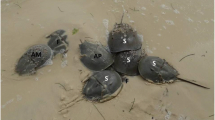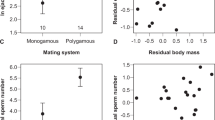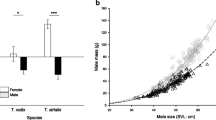Abstract
Populations of a single species may vary substantially in sexually selected traits. However, the majority of studies investigating such variation across populations have focused on traits important for pre-copulatory reproductive success, such as male ornamentation or song. Relatively fewer studies have investigated whether traits important in post-copulatory sexual selection vary across populations. In this study, we examine how sperm and ejaculate quantity and quality in the American horseshoe crab, Limulus polyphemus differ at six sites, from Maine to Florida. Horseshoe crabs from these sites differ in many respects, including average body size, age, and the risk and intensity of sperm competition as measured by the operational sex ratio. We find that sperm and ejaculate quantity and quality significantly differ across this range and that this variation persists after taking body size and age into account. Sperm traits also do not follow strictly linear latitudinal clines. Finally, we find that the site-specific operational sex ratio correlates with changes in sperm and ejaculate quantity. This latter result may indicate that the same processes that lead to variation in post-copulatory sexually selected traits across related species may also promote trait divergence across populations of the same species.
Significance statement
This study describes variation in sperm and ejaculate traits from horseshoe crabs collected at six sites from Maine to Florida. While geographic variation has been described for many traits, relatively few studies have demonstrated that sperm and ejaculate traits follow similar patterns. The variation we found does not follow simple latitudinal patterns, suggesting that other forces may be driving sperm and ejaculate trait divergence across sites. We also have data that suggest sexual selection may play a role in driving sperm trait variation, but we caution that additional sites need to be sampled.


Similar content being viewed by others

References
Balshine S, Leach BJ, Neat F, Werner NY, Montgomerie R (2001) Sperm size of African cichlids in relation to sperm competition. Behav Ecol 12:726–731
Benham WBS (1884) On the testis of Limulus. Trans Linn Soc Lond 2:363–366
Benzie J, Dixon P (1994) The effects of sperm concentration, sperm: egg ratio, and gamete age on fertilization success in crown-of-thorns starfish (Acanthaster planci) in the laboratory. Bio Bull 186:139–152
Birkhead TR, Pellatt EJ, Brekke P, Yeates R, Castillo-Juarez H (2005) Genetic effects on sperm design in the zebra finch. Nature 434:383–387
Brockmann HJ (1990) Mating-behaviour of horseshoe crabs, Limulus polyphemus. Behaviour 114:206–220
Brockmann HJ (2002) An experimental approach to altering mating tactics in male horseshoe crabs (Limulus polyphemus). Behav Ecol 13:232–238
Brockmann HJ, Penn D (1992) Male mating tactics in the horseshoe crab, Limulus polyphemus. Anim Behav 44:653–665
Brockmann HJ, Smith MD (2009) Reproductive competition and sexual selection in horseshoe crabs. In: Tanacredi JT, Botton ML, Smith DR (eds) Biology and conservation of horseshoe crabs. Springer, New York, NY, pp 199–221
Brockmann HJ, Colson T, Potts W (1994) Sperm competition in horseshoe crabs (Limulus polyphemus). Behav Ecol Sociobiol 35:153–160
Brockmann HJ, Nguyen C, Potts W (2000) Paternity in horseshoe crabs when spawning in multiple-male groups. Anim Behav 60:837–849
Brockmann HJ, Johnson SL, Smith MD, Sasson D (2015) Mating tactics of the American horseshoe crab (Limulus polyphemus). In: Changing global perspectives on horseshoe crab biology, conservation and management. Springer., pp 321–351
Byrne PG, Simmons LW, Roberts JD (2003) Sperm competition and the evolution of gamete morphology in frogs. Proceedings of the Royal Society of London Series B-Biological Sciences 270:2079–2086
Clapper DL, Brown GG (1980a) Sperm motility in the horseshoe-crab, Limulus polyphemus L.1. sperm behavior near eggs and motility initiation by egg extracts. Dev Biol 76:341–349
Clapper DL, Brown GG (1980b) Sperm motility in the horseshoe-crab, Limulus polyphemus L.2. partial characterization of a motility initiating factor from eggs and the effects of inorganic cations on motility initiation. Dev Biol 76:350–357
Crudgington HS, Fellows S, Badcock NS, Snook RR (2009) Experimental manipulation of sexual selection promotes greater male mating capacity but does not alter sperm investment. Evolution 63:926–938
Dziminski MA, Roberts JD, Beveridge M, Simmons LW (2010) Among-population covariation between sperm competition and ejaculate expenditure in frogs. Behav Ecol 21:322–328
Elgee K, Evans J, Ramnarine I, Rush S, Pitcher T (2010) Geographic variation in sperm traits reflects predation risk and natural rates of multiple paternity in the guppy. J Evol Biol 23:1331–1338
Emlen ST, Oring LW (1977) Ecology, sexual selection, and evolution of mating systems. Science 197:215–223
Endler JA, Houde AE (1995) Geographic-variation in female preferences for male traits in Poecilia reticulata. Evolution 49:456–468
Evans JP, Magurran AE (1999) Geographic variation in sperm production by Trinidadian guppies. Proc R Soc Lond Ser B-Biol Sci 266:2083–2087
Fahrenbach W (1973) Spermiogenesis in horseshoe crab Limulus polyphemus. Journal of Morphology 140:31–51
Firman RC, Garcia‐Gonzalez F, Thyer E, Wheeler S, Yamin Z, Yuan M, Simmons LW (2015) Evolutionary change in testes tissue composition among experimental populations of house mice. Evolution 69:848–855
Fitzpatrick JL, Montgomerie R, Desjardins JK, Stiver KA, Kolm N, Balshine S (2009) Female promiscuity promotes the evolution of faster sperm in cichlid fishes. P Natl Acad Sci USA 106:1128–1132
Gage MJG (1994) Associations between body-size, mating pattern, testis size and sperm lengths across butterflies. Proc R Soc Lond Ser B-Biol Sci 258:247–254
Gage A, Barnard C (1996) Male crickets increase sperm number in relation to competition and female size. Behav Ecol Sociobiol 38:349–353
Gage MJG, Stockley P, Parker GA (1995) Effects of alternative male mating strategies on characteristics of sperm production in the Atlantic salmon (Salmo salar): theoretical and empirical investigations. Philos T R Soc B 350:391–399
Gage MJG, Macfarlane CP, Yeates S, Ward RG, Searle JB, Parker GA (2004) Spermatozoal traits and sperm competition in Atlantic salmon: relative sperm velocity is the primary determinant of fertilization success. Currt Biol 14:44–47
Gomendio M, Roldan ERS (1991) Sperm competition influences sperm size in mammals. Proc R Soc Lond Ser B-Biol Sci 243:181–185
Hettyey A, Roberts JD (2006) Sperm traits of the quacking frog, Crinia georgiana: intra- and interpopulation variation in a species with a high risk of sperm competition. Behav Ecol Sociobiol 59:389–396
Hosken DJ, Garner TWJ, Ward PI (2001) Sexual conflict selects for male and female reproductive characters. Currt Biol 11:489–493
Hunter FM, Birkhead TR (2002) Sperm viability and sperm competition in insects. Currt Biol 12:121–123
Immler S, Pryke SR, Birkhead TR, Griffith SC (2010) Pronounced within-individual plasticity in sperm morphometry across social environments. Evolution 64:1634–1643
Irwin DE (2000) Song variation in an avian ring species. Evolution 54:998–1010
Johnson KT (2016) Population genetic analysis of Atlantic horseshoe crabs (Limulus polyphemus) in Coastal Massachusetts. University of Massachusetts
King TL, Eackles MS, Spidle AP, Brockmann HJ (2005) Regional differentiation and sex-biased dispersal among populations of the horseshoe crab Limulus polyphemus. T Am Fish Soc 134:441–465
King TL, Eackles MS, Aunins AW, Brockmann HJ, Hallerman E, Brown BL (2015) Conservation genetics of the American horseshoe crab (Limulus polyphemus): allelic diversity, zones of genetic discontinuity, and regional differentiation. In: Changing global perspectives on horseshoe crab biology, conservation and management. Springer., pp 65–96
Kleven O, Fossøy F, Laskemoen T, Robertson RJ, Rudolfsen G, Lifjeld JT (2009) Comparative evidence for the evolution of sperm swimming speed by sperm competition and female sperm storage duration in passerine birds. Evolution 63:2466–2473
Laskemoen T, Albrecht T, Bonisoli-Alquati A, Cepak J, de Lope F, Hermosell IG, Johannessen LE, Kleven O, Marzal A, Mousseau TA, Møller AP, Robertson RJ, Rudolfsen G, Saino N, Vortman Y, Lifjeld JT (2013) Variation in sperm morphometry and sperm competition among barn swallow (Hirundo rustica) populations. Behav Ecol Sociobiol 67:301–309
Levitan DR (2000) Sperm velocity and longevity trade off each other and influence fertilization in the sea urchin Lytechinus variegatus. Proc R Soc Lond Ser B-Biol Sci 267:531–534
Levitan DR, Sewell MA, Chia F-S (1991) Kinetics of fertilization in the sea urchin Strongylocentrotus franciscanus: interaction of gamete dilution, age, and contact time. Biol Bull 181:371–378
Lindholm AK, Head M, Brooks R, Rollins L, Ingleby F, Zajitschek SR (2014) Causes of male sexual trait divergence in introduced populations of guppies. J Evol Biol 27:437–448
Lüpold S (2013) Ejaculate quality and constraints in relation to sperm competition levels among eutherian mammals. Evolution 67:3052–3060
Lüpold S, Linz GM, Birkhead TR (2009a) Sperm design and variation in the New World blackbirds (Icteridae). Behav Ecol Sociobiol 63:899–909
Lüpold S, Linz GM, Rivers JW, Westneat DF, Birkhead TR (2009b) Sperm competition selects beyond relative testes size in birds. Evolution 63:391–402
Lüpold S, Westneat DF, Birkhead TR (2011) Geographical variation in sperm morphology in the red-winged blackbird (Agelaius phoeniceus). Evol Ecol 25:373–390
Manier MK, Palumbi SR (2008) Intraspecific divergence in sperm morphology of the green sea urchin, Strongylocentrotus droebachiensis: implications for selection in broadcast spawners. Bmc Evol Biol 8:283
Morrow EH, Gage MJG (2001) Sperm competition experiments between lines of crickets producing different sperm lengths. Proc R Soc Lond Ser B-Biol Sci 268:2281–2286
Neff BD, Fu P, Gross MR (2003) Sperm investment and alternative mating tactics in bluegill sunfish (Lepomis macrochirus). Behav Ecol 14:634–641
Oppliger A, Hosken D, Ribi G (1998) Snail sperm production characteristics vary with sperm competition risk. Proc R Soc Lond Ser B-Biol Sci 265:1527–1534
Parker GA (1982) Why are there so many tiny sperm - sperm competition and the maintenance of 2 sexes. J Theor Biol 96:281–294
Parker GA (1998) Sperm competition and the evolution of ejaculates: towards a theory base. In: Birkhead TR, quot f-f, Cambria, quot, p.MsoNormal lMdM, pt f-s, quot f-f, Roman, quot TN, Section dS, Møller AP (eds) Sperm Competition and Sexual Selection. Academic Press, pp 3 - 54
Penn D, Brockmann HJ (1995) Age-biased stranding and righting in male horseshoe crabs, Limulus polyphemus. Anim Behav 49:1531–1539
Pitcher TE, Stutchbury BJM (1998) Latitudinal variation in testis size in six species of North American songbirds. Can J Zoolog 76:618–622
Pitnick S, Miller GT, Schneider K, Markow TA (2003) Ejaculate-female coevolution in Drosophila mojavensis. Proc R Soc Lond Ser B-Biol Sci 270:1507–1512
Riska B (1981) Morphological variation in the horseshoe-crab Limulus polyphemus. Evolution 35:647–658
Rowe M, Pruett-Jones S (2011) Sperm competition selects for sperm quantity and quality in the Australian Maluridae. PLoS One 6:e15720–e15720
Rudolfsen G, Figenschou L, Folstad I, Kleven O (2008) Sperm velocity influence paternity in the Atlantic cod (Gadus morhua L.). Aquac Res 39:212–216
Rurangwa E, Kime DE, Ollevier F, Nash JP (2004) The measurement of sperm motility and factors affecting sperm quality in cultured fish. Aquaculture 234:1–28
Sasson DA, Johnson SL, Brockmann HJ (2012) The role of age on sperm traits in the American horseshoe crab, Limulus polyphemus. Anim Behav 84:975–981
Sasson DA, Johnson SL, Brockmann HJ (2015) Reproductive tactics and mating contexts affect sperm traits in horseshoe crabs (Limulus polyphemus). Behav Ecol Sociobiol 69:1769–1778
Sasson DA, Munoz PR, Gezan SA, Miller CW (2016) Resource quality affects weapon and testis size and the ability of these traits to respond to selection in the leaf‐footed cactus bug, Narnia femorata. Ecol Evol 6:2098–2108
Schreibman MP, Zarnoch CB (2009) Aquaculture methods and early growth of juvenile horseshoe crabs (Limulus polyphemus). In: Tanacredi JT, Botton ML, Smith DR (eds) Biology and conservation of horseshoe crabs. Springer, New York
Shine R, Fitzgerald M (1995) Variation in mating systems and sexual size dimorphism between populations of the Australian python Morelia spilota (Serpentes, Pythonidae). Oecologia 103:490–498
Shuster CN (1955) On morphometric and serological relationships within the Limulidae, with particular reference to Limulus polyphemus (L.). New York University
Shuster CN, Botton ML (1985) A contribution to the population biology of horseshoe crabs, Limulus polyphemus (L.), in Delaware Bay. Estuaries 8:363–372
Shuster CJ, Sekiguchi K (2003) Growing up takes about ten years and eighteen stages. In: Shuster CJ, Barlow R, Brockmann H (eds) The American horseshoe crab. Harvard University Press, Cambridge, pp 103–132
Simmons LW, García‐González F (2008) Evolutionary reduction in testes size and competitive fertilization success in response to the experimental removal of sexual selection in dung beetles. Evolution 62:2580–2591
Simmons LW, Moore AJ (2009) Evolutionary quantitative genetics of sperm. In: Birkhead TR, Hosken DJ, Pitnick S (eds) Sperm biology: an evolutionary perspective. Academic, Oxford, UK
Smith DR, Brousseau LJ, Mandt MT, Millard MJ (2010) Age and sex specific timing, frequency, and spatial distribution of horseshoe crab spawning in Delaware Bay: insights from a large-scale radio telemetry array. Curr Zool 56:563–574
Smith MD, Brockmann HJ (2014) The evolution and maintenance of sexual size dimorphism in horseshoe crabs: an evaluation of six functional hypotheses. Anim Behav 96:127–139
Snook RR (2001) Absence of latitudinal clines in sperm characters in North American populations of Drosophila subobscura (Diptera : Drosophilidae). Pan-Pac Entomol 77:261–271
Snook RR (2005) Sperm in competition: not playing by the numbers. Trends Ecol Evol 20:46–53
Stewart KA, Wang R, Montgomerie R (2016) Extensive variation in sperm morphology in a frog with no sperm competition. BMC Evol Biol 16:1
Stockley P, Gage MJG, Parker GA, Møller AP (1996) Female reproductive biology and the coevolution of ejaculate characteristics in fish. Proc R Soc Lond Ser B-Biol Sci 263:451–458
Stockley P, Gage MJG, Parker GA, Møller AP (1997) Sperm competition in fishes: the evolution of testis size and ejaculate characteristics. Am Nat 149:933–954
Stoltz JA, Neff BD (2006) Sperm competition in a fish with external fertilization: the contribution of sperm number, speed and length. J Evol Biol 19:1873–1881
Tomkins JL, Simmons LW (2002) Measuring relative investment: a case study of testes investment in species with alternative male reproductive tactics. Anim Behav 63:1009–1016
Wedell N, Cook PA (1999) Butterflies tailor their ejaculate in response to sperm competition risk and intensity. Proc R Soc Lond Ser B-Biol Sci 266:1033–1039
Wilson-Leedy JG, Ingermann RL (2007) Development of a novel CASA system based on open source software for characterization of zebrafish sperm motility parameters. Theriogenology 67:661–672
Acknowledgments
We especially thank Melissa Clark for her help in collecting samples from FL to MA. We received additional help at various sampling sites from, but not limited to, Gracie Townsend and Brian Silliman (GA); Gary Kraemer (DE); Jennifer Mattei (CT); Sarah Martinez and Katherine Johnson (MA); and Pete Thayer, Kristen Aaltonen, and Eric Aaltonen (ME). We also thank the Stolarz Foundation and the National Science Foundation (IOB 06-41750) whose grants made sampling at these sites possible. Finally, we thank two anonymous reviewers for their many helpful comments on this manuscript.
Author information
Authors and Affiliations
Corresponding author
Ethics declarations
Funding
This study was funded by the National Science Foundation (IOB 06-41750) and the Stolarz Foundation.
Conflict of interest
The authors declare that they have no competing interests.
Ethical approval
All applicable international, national, and/or institutional guidelines for the care and use of animals were followed.
Additional information
Communicated by N. Wedell
Rights and permissions
About this article
Cite this article
Sasson, D.A., Brockmann, H.J. Geographic variation in sperm and ejaculate quantity and quality of horseshoe crabs. Behav Ecol Sociobiol 70, 1715–1725 (2016). https://doi.org/10.1007/s00265-016-2177-0
Received:
Revised:
Accepted:
Published:
Issue Date:
DOI: https://doi.org/10.1007/s00265-016-2177-0



